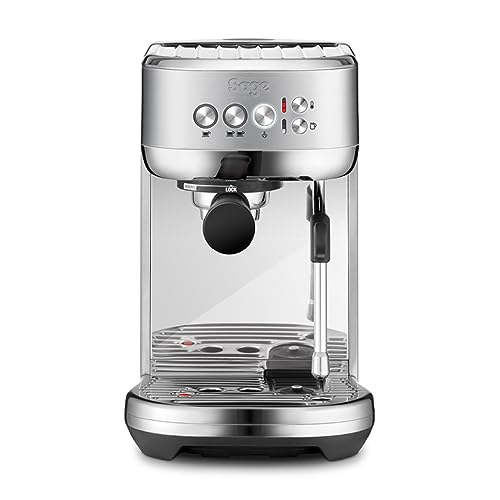How Does Machine Espresso Work?

Machine espresso makes use of precise pressure and mind-blowing filter technology to create the perfect cup of coffee. How exactly does it work?
To make an espresso, hot water is forced under high pressure through finely ground coffee. The process is similar to making drip coffee, but the difference is in the pressure.
The Group Head
The group head is the portafilter you insert when brewing espresso. It disperses water into the portafilter, and then regulates the pressure during the extraction. There are a variety of types of group heads, each with their unique advantages and drawbacks. Some focus on temperature stability, some on pre-infusion features, and others are designed to control the lever. Some come with a combination of both, such as the E61. This is a preferred choice for baristas because it offers multiple advantages in a single package.
As you can see from the image above the head of the group is fitted with a variety of notches. You can place your portafilter inside these notches, and then turn the head around to secure it. There is also a gasket made from rubber that is a part of the notches and helps create an airtight seal when you insert your portafilter into the machine. The notches on the head allow for an exact placement of the portafilter, which is necessary for a consistent extraction.
In addition to allowing you easily insert your portafilter, the group head is responsible for maintaining an even temperature. It does this by cycling hot water through the brew container and around the portafilter to ensure that it's always at the right temperature to extract. It is important to note that even a tiny deviation can make the difference between a good and a excellent espresso.
The Pump
Contrary to manual piston machines which rely on a lever that pressurize water, rotating espresso machines rely upon motorized pumps to supply the nine atmospheric bars of pressure necessary for espresso extraction. This pressure is built up by pumping water through a heat-exchanger and then through the ground coffee.
Pumps tend to be less expensive than piston-driven machines, and they tend to last longer. However, both types of machines can be damaged by excessive use and inadequate cleaning. They also increase the complexity of mechanical systems that can lead to the cost of even the simplest models.
Some espresso machines remove the pump completely and instead use steam pressure to brew espresso. The disadvantage of this is that the boiler that produces steam also increases the temperature of water to the point of boiling and can result in excessive extraction. The machines also need to continuously rebuild their pressure between cups. This requires energy and time.
Many espresso machines make use of either a vibration or rotary pump. A vibration model makes use of an oscillating disk to create pressure, whereas a Rotary model pushes hot coffee through the ground at high speed. Both machines produce great espresso however rotary machines tend to be more quiet, durable and less likely to break.
The Boiler
The boiler is the part that heats the water to the optimal temperature to extract. The steam that is produced reaches the portafilter containing ground espresso beans and is then pumped into the cup. During this process, the steam creates pressure and pushes through the grounds of the coffee. This produces a layer of crema on top. This is a sign of a good espresso.
There are three types of espresso makers. They differ in the type of pump they employ and how hot the coffee is. There are a variety of ways in which the brew can be controlled as well as the size of the cup that the machine is capable of making.
The earliest espresso machines were steam type. They had one boiler to make both steam and brew, however, the pressure they could produce was very low - just two bars of atmospheric pressure maximum. The coffee tasted bitter and burnt. coffeee is why Milanese manufacturers Luigi Bezzerra and Desiderio Pavoni developed the modern espresso machine.
The most well-known espresso maker is a semi-automatic one with an electric pump. When people think of espresso machines, they imagine these machines. Semi-automatic machines require you to grind and tamp the beans yourself while the pump controls the water flow and pressure. This is an excellent compromise between human touch and mechanized quality.
The Filter
Typically, espresso machines have filters to separate the coffee grounds as they pass through the hot water. The filter is also a vital component of the machine's temp control, since it helps to prevent overheating.
Filters also aid in flavor because it allows for an extended flowering time. This allows the beans to let their nuances out and provides the chance for better extraction.
However, it is important to keep in mind that even a top filter could result in a bad cup of coffee as the quality of the beans and extraction are crucial.
It's here that the magic occurs. This is what makes espresso taste so good. The grouphead, sometimes called the brew head, is the place where the portafilter (the thingy you put the ground coffee into) sits when you're making espresso.
Steam-driven espresso machines use hot water that is heated in an airtight container to produce steam. The steam then moves hot water through the coffee grounds under high pressure. These types of machines are typically cheaper and easier to maintain than pump-driven models. However, they are limited in their ability to provide the perfect brewing conditions since they operate at 1-1.5 bars of pressure. The perfect shot requires 9-10 bars.
In recent years, compressed air-driven espresso machines have been gaining popularity. They use an air compressor to push hot water across the ground and are more mobile than electric steam-driven espresso machines.
